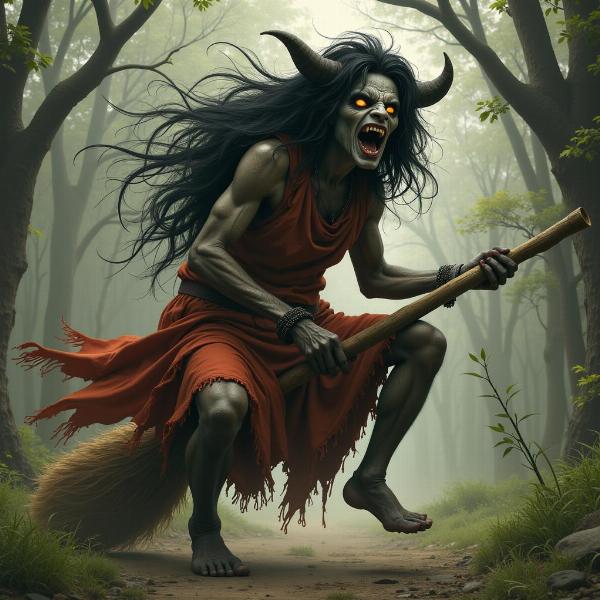The Hindi word “dayan” (दयान) evokes a powerful image in Indian culture, often associated with fear and superstition. Understanding the true meaning of “dayan,” however, requires delving deeper than surface-level interpretations. This article explores the various facets of “dayan meaning in hindi,” examining its origins, cultural significance, and common misconceptions.
Unveiling the Meaning of Dayan (दयान)
“Dayan” is the Hindi word for “witch.” It refers to a female practitioner of witchcraft or black magic, believed to possess supernatural powers and use them for malevolent purposes. While the English translation “witch” offers a basic understanding, it doesn’t fully capture the cultural nuances associated with “dayan” in the Indian context.
 Dayan in Indian Folklore
Dayan in Indian Folklore
Dayan in Indian Folklore and Mythology
The concept of the “dayan” is deeply ingrained in Indian folklore and mythology. Stories often depict them as malevolent figures who use their powers to cause harm, inflict curses, and manipulate events. They are often associated with darkness, cremation grounds, and the practice of occult rituals. These tales, passed down through generations, have contributed to the enduring perception of “dayan” as figures of fear and dread.
Cultural Significance and Misconceptions
The cultural significance of “dayan” extends beyond mere storytelling. In some communities, the belief in witches is still prevalent, and accusations of witchcraft can lead to social ostracization and even violence. It’s important to distinguish between the mythical figure of the “dayan” and the real-world persecution of individuals accused of witchcraft. Often, marginalized women are targeted, reflecting deeply ingrained societal biases.
Dayan vs. Daayan: A Linguistic Nuance
The word “dayan” is sometimes spelled as “daayan” (डा़यन). While both spellings are used interchangeably, “daayan” is considered the more accurate transliteration in some linguistic contexts. This subtle difference in spelling doesn’t change the core meaning of the word.
The Dayan in Popular Culture
The image of the “dayan” has been frequently portrayed in Indian cinema and literature, often reinforcing existing stereotypes. However, some contemporary works have attempted to explore the complexities of this figure, portraying them with greater nuance and depth. This evolution in representation reflects a growing awareness of the social implications associated with the belief in witchcraft.
What is the Hindi Meaning of Witchcraft?
The Hindi term for witchcraft is “jadu-tona” (जादू-टोना). This term encompasses a range of practices involving magic and spells, often associated with both benevolent and malevolent intentions. Understanding the broader context of “jadu-tona” helps to further contextualize the role of the “dayan” within Indian belief systems.
Conclusion: Beyond the Stereotypes
Understanding the “dayan meaning in hindi” requires going beyond simplistic definitions and delving into its rich cultural and historical context. While the “dayan” is often portrayed as a figure of fear and evil, it’s crucial to recognize the complexities and misconceptions surrounding this figure. By exploring the various facets of the “dayan,” we can gain a deeper appreciation of the intricate tapestry of Indian folklore and its impact on contemporary society.
FAQ: Common Questions about Dayan
- What is the difference between a dayan and a chudail? While both are female supernatural entities in Indian folklore, a dayan is primarily associated with witchcraft, while a chudail is typically the spirit of a woman who died during childbirth or pregnancy.
- Are dayans real? The existence of dayans is a matter of belief and folklore. There is no scientific evidence to support their existence.
- What are the powers of a dayan? Folklore attributes various powers to dayans, including the ability to cast spells, shape-shift, and control minds.
- How can one protect themselves from a dayan? Traditional beliefs often involve rituals, amulets, and seeking the help of religious figures for protection against a dayan.
- Is the concept of dayan unique to India? Similar figures associated with witchcraft exist in various cultures around the world, although the specific beliefs and practices may differ.
- Why are dayans mostly portrayed as women? The portrayal of dayans as women reflects historical and social biases against women, particularly those who are marginalized or seen as different.
- What is the modern-day relevance of the dayan myth? The dayan myth continues to be relevant in understanding cultural beliefs, societal prejudices, and the power of folklore in shaping perceptions.
Meaning-Hindi.in is your premier destination for professional Hindi translation services, catering to diverse needs from business documents and legal papers to technical manuals, website localization, and academic texts. We provide accurate, culturally sensitive translations with a focus on quality and client satisfaction. Whether you need a quick turnaround for a small project or in-depth expertise for specialized content, our expert team is here to help. Contact us today for all your Hindi translation needs! Email: [email protected], Phone: +91 11-4502-7584. Meaning-Hindi.in offers a range of specialized services including legal, technical, and educational translation, ensuring precision and cultural sensitivity across various fields.